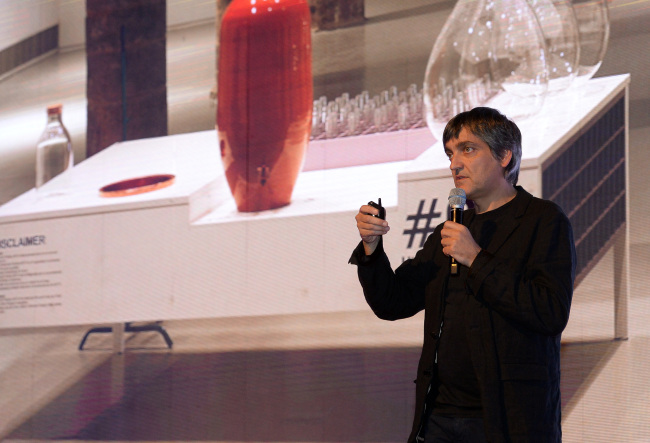[HERALD DESIGN FORUM 2015]
Considering food as design object
Food is not merely a crucial means of maintaining health and nutrition, but also an “object” of design that is perceived, contextualized and consumed, a Spanish food design guru said Tuesday.
“Thinking food as an object is very important. If we view it as an object, it can (be) full of meanings and experiences, if it is well designed. This edible object can be designed with parameters such as ergonomics, functionality, usability and so forth,” said food designer Marti Guixe in a session at the Herald Design Forum 2015 held in central Seoul.

Marti Guixe delivers a speech in a session at the Herald Design Forum 2015 held in central Seoul. (Ahn Hoon/The Korea Herald)
Guixe, originally an interior and industrial designer, became a pioneer in food design in the late 1990s. It all started when he put a spin on a traditional Spanish dish. He took out the inside of the squeezed tomato and put the Catalan bread inside it, instead of under it as traditionally done, creating a whole new structure for the dish. Since then, food has become the source of his work.
For him, design is more of a platform for questioning rather than a creation of an unconventional object. His food design is characterized by his dislike of design as stylized object and form as he pursues altering the way of seeing and perceiving, rather than reshaping existing products.
“I design concepts and ideas with food that is mass produced and mass consumed by the public. The design of food can be thought, contextualized, ritualized and consumed as an object,” the 51-year-old said.
He came up with the idea of a “hands-free lollipop,” a lollipop that can stand upright on three sticks and does not need to be held by a hand.
The unconventional pie-chart cake also offered a breakthrough in design. The different colors of the cake sectioned in the form of a pie-chart showed how much of each ingredient was used.
While his interest in food placed him in the top tier of his field, he, ironically, does not know how to cook.
“To be honest. I have no idea of cooking,” he added with a laugh. “I view food as a designer, which actually frees me from thinking of the process of cooking and helps me focus on the usability and the social elements surrounding it.”
He added, however, that working with experts of gastronomy nutrition is important as the taste and nutrition are technical parts of the design project.
“I don’t think that design is only based on aesthetics. It’s also based on functions in the way you use and you eat, where and how you decided to eat it,” he added.
While expanding his career in food design, Guixe has led a number of exhibitions and commercial collaborations with various brands, including Alessi, Camper, Chupa Chups and Desigual.
By Lee Hyun-jeong (rene@heraldcorp.com)